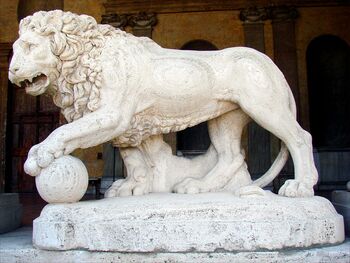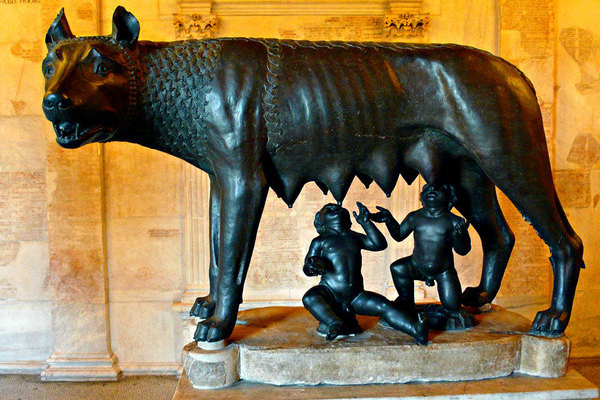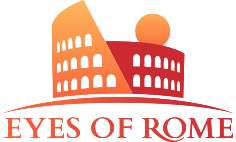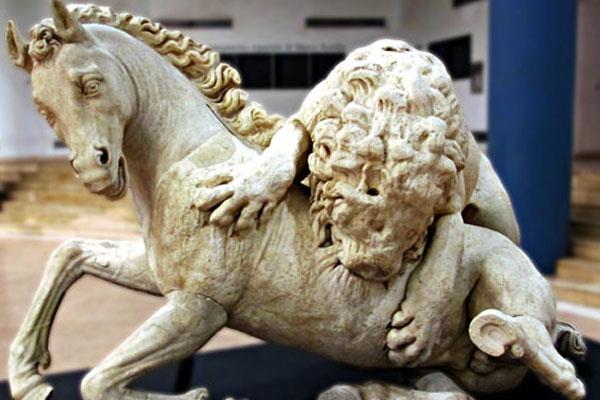Other than historians, there are few people who remember the lion as the powerful symbol of an independent Rome.
Most people today think of the she-wolf as the symbol of Rome.
 Until the Renaissance, however, it was the lion - a symbol of strength, sovereignty and justice — that embodied Rome’s secular government.
Until the Renaissance, however, it was the lion - a symbol of strength, sovereignty and justice — that embodied Rome’s secular government.
During the Middle Ages, at the bottom of the grand staircase leading to the Senatorial Palace on the Capitoline Hill, was an ancient statue of a Lion attacking a Horse. It was in front of this lion that death sentences were announced and sometimes carried out.
Medieval Rome was so strongly associated with the lion that people believed the city was laid out in the shape of this beast.
"The very walls of the city have been built in the shape of a lion"
Cola di Rienzo - politician and popular leader in the 14th century
The king of Naples, Robert of Anjou, even went so far as to gift a lion to the city of Rome. The city’s magistrates were so pleased they subsequently requested live lions from the Medici family in Florence.
Kept in cages on the Capitoline Hill (a scary thought- they occasionally escaped!) the lions embodied the city’s political authority until the late 15th century, when the pope’s wolf took over the lion’s territory.
The she-wolf represented the power of the papacy. For pagans and Christians it served as a sacred symbol and a reminder of the bond between this world and the next. Pagans associated the wolf with Mars, the god of war. The legend of Romulus and Remus nurtured by a she-wolf therefore symbolized the warrior spirit of the Romans. Christians appropriated the symbol by believing wolves were agents of God sent to punish sinners, or agents of the Devil sent to test one’s faith. In both instances wolf iconography is crucial for the teachings of the Catholic Church.
 The she-wolf who nursed and sheltered the infants Romulus and Remus after they were abandoned
The she-wolf who nursed and sheltered the infants Romulus and Remus after they were abandoned
A famous bronze sculpture of the Capitoline She-Wolf occupied the Lateran Palace of the popes until 1471, when it was donated to the municipality of Rome by Pope Sixtus IV. This she-Wolf was one of several ancient sculptures “returned” to the Romans at this time, an event that kick-started a fervor for Roman antiquities and led to the founding of the Capitoline Museums.

She-wolf, bronze statue, Musei Capitolini - Roma
This gift from church to state was not without a political motive. In his persistent attempts to fashion Rome into the capital of Christendom, and diminish the power of the independent municipality of Rome, Sixtus IV specified that the She-Wolf was to be placed on the facade of the Palazzo dei Conservatori for all to see.
Political control over the city had thus literally and symbolically been transferred to the papal court, and the Capitoline Hill, which once stood for the municipality’s independence (embodied by the proud lion) came to signify instead knowledge of the past through Christian teaching (embodied by the she-wolf).
After Michelangelo redesigned the piazza, the sculpture of the Capitoline She-Wolf was brought inside the loggia of the Palazzo dei Conservatori, in what is now the Hall of the She-Wolf, where we can still admire it today.
And the ferocious Roman lion? The sculpture is proudly displayed in Marcus Aurelius Exedra of the Capitoline Museums, but other than historians, there are few people who remember it as the powerful symbol of an independent Rome.
Want to know more about Rome and the Romans? Book our Rome Squares and Fountains Walking Tour!


